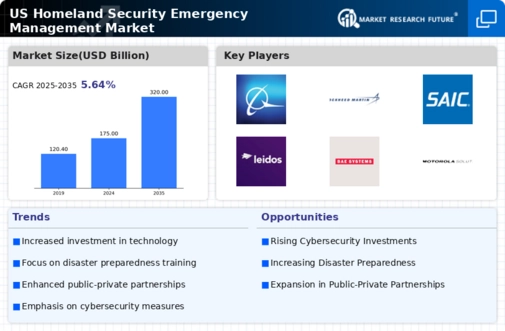Rising Threat Levels
The homeland security-emergency-management market is increasingly influenced by the rising threat levels posed by both domestic and international actors. The frequency of cyberattacks, terrorism, and natural disasters has escalated, prompting a reevaluation of security protocols. For instance, the FBI reported a 30% increase in cybercrime incidents in 2025 compared to previous years. This alarming trend necessitates the adoption of advanced security solutions and emergency management strategies. Consequently, organizations are compelled to invest in cutting-edge technologies and training to mitigate these threats effectively. The heightened awareness of vulnerabilities within critical infrastructure and public safety systems indicates a growing demand for services within the homeland security-emergency-management market. As threats evolve, the industry is likely to adapt, fostering innovation and resilience in response to these challenges.
Technological Advancements
Technological advancements are playing a pivotal role in shaping the homeland security-emergency-management market. Innovations in artificial intelligence, machine learning, and data analytics are transforming how agencies respond to emergencies and manage security threats. For example, the integration of AI-driven surveillance systems has improved threat detection capabilities, allowing for quicker responses to incidents. The market is projected to grow at a CAGR of 7% from 2025 to 2030, driven by the increasing adoption of these technologies. Furthermore, the development of mobile applications for emergency management enhances communication and coordination among agencies and the public. As technology continues to evolve, it is likely to create new opportunities for companies within the homeland security-emergency-management market, enabling them to offer more effective solutions to meet the demands of a dynamic security landscape.
Increased Government Funding
The homeland security-emergency-management market is experiencing a notable surge in government funding aimed at enhancing national security measures. In recent years, federal allocations have increased significantly, with the Department of Homeland Security (DHS) receiving approximately $52 billion in 2025 alone. This financial support is directed towards advanced technologies, training programs, and infrastructure improvements. The emphasis on securing borders, preventing terrorism, and responding to natural disasters has led to a robust investment landscape. This focus has resulted in significant financial support for the sector. As a result, companies operating within the homeland security-emergency-management market are likely to benefit from this influx of capital, enabling them to innovate and expand their service offerings. The ongoing commitment from the government to bolster security measures suggests a sustained growth trajectory for the industry, as funding is expected to remain a critical driver in the coming years.
Public Awareness and Engagement
Public awareness and engagement are emerging as critical drivers in the homeland security-emergency-management market. As communities become more informed about potential threats, there is a growing demand for educational programs and resources that promote preparedness. Initiatives such as community training sessions and public safety campaigns are gaining traction, fostering a culture of resilience. The Federal Emergency Management Agency (FEMA) has reported that communities with higher levels of preparedness experience 40% less damage during disasters. This correlation underscores the importance of engaging the public in emergency management efforts. Consequently, organizations within the homeland security-emergency-management market are likely to focus on developing outreach programs and partnerships with local governments to enhance community resilience. The emphasis on public involvement suggests a shift towards a more collaborative approach in addressing security challenges.
Legislative and Regulatory Changes
Legislative and regulatory changes are significantly impacting the homeland security-emergency-management market. Recent policy shifts have introduced new compliance requirements for organizations involved in security and emergency management. For instance, the implementation of stricter cybersecurity regulations has compelled companies to enhance their security protocols. The Cybersecurity and Infrastructure Security Agency (CISA) has outlined guidelines that organizations must follow to protect critical infrastructure. This evolving regulatory landscape is likely to drive demand for consulting services and compliance solutions within the market. Additionally, as new laws are enacted to address emerging threats, companies will need to adapt their strategies to remain compliant. The dynamic nature of legislation in the homeland security-emergency-management market indicates that organizations must stay informed and agile to navigate these changes effectively.

















Leave a Comment